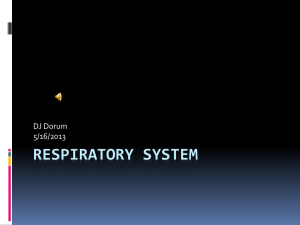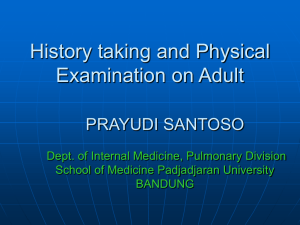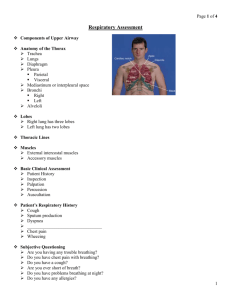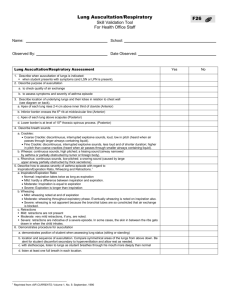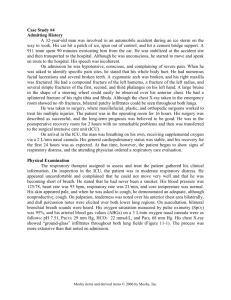Diagnostic Reasoning for Advanced Nursing
advertisement
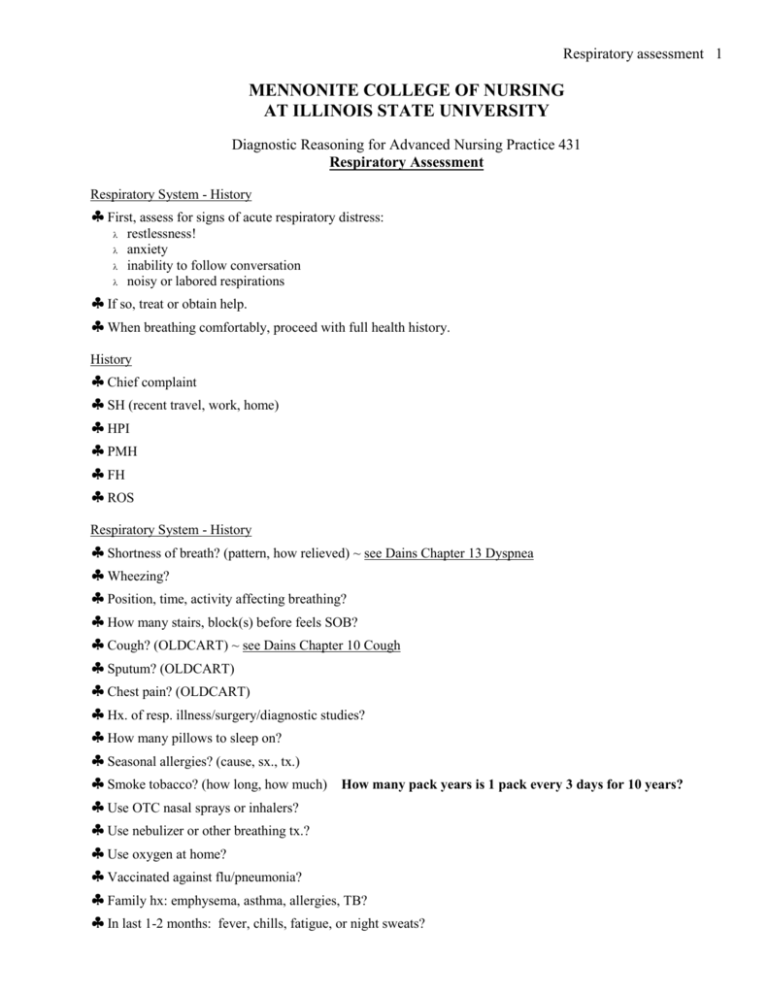
Respiratory assessment 1 MENNONITE COLLEGE OF NURSING AT ILLINOIS STATE UNIVERSITY Diagnostic Reasoning for Advanced Nursing Practice 431 Respiratory Assessment Respiratory System - History First, assess for signs of acute respiratory distress: restlessness! anxiety inability to follow conversation noisy or labored respirations If so, treat or obtain help. When breathing comfortably, proceed with full health history. History Chief complaint SH (recent travel, work, home) HPI PMH FH ROS Respiratory System - History Shortness of breath? (pattern, how relieved) ~ see Dains Chapter 13 Dyspnea Wheezing? Position, time, activity affecting breathing? How many stairs, block(s) before feels SOB? Cough? (OLDCART) ~ see Dains Chapter 10 Cough Sputum? (OLDCART) Chest pain? (OLDCART) Hx. of resp. illness/surgery/diagnostic studies? How many pillows to sleep on? Seasonal allergies? (cause, sx., tx.) Smoke tobacco? (how long, how much) How many pack years is 1 pack every 3 days for 10 years? Use OTC nasal sprays or inhalers? Use nebulizer or other breathing tx.? Use oxygen at home? Vaccinated against flu/pneumonia? Family hx: emphysema, asthma, allergies, TB? In last 1-2 months: fever, chills, fatigue, or night sweats? Respiratory assessment 2 Anemia? Polycythemia? Sinus problems? History: Children Particulars Respiratory problems at birth? (treatment?) Frequent congestion, runny nose, colds? Does SOB interfere with taking bottle? Does cough/SOB interfere with child’s play or school activities? Cough at night? Does child awaken? History: Elderly Elements Aware of any changes in breathing patterns? Easily fatigued when climbing stairs? Trouble breathing when lying flat? Seem to have more colds that last longer? Health Promotion Questions Last CXR? Last TB test? Tobacco cessation? Immunizations? Home remedies used for resp. problems? Need assistance for activities? $ for meds? Any hobbies with respiratory irritants? 3 large meals or several small meals? Does work/home stress affect breathing? Home: others-NH, pets, heating, dust, mold, where sleeping? Examination of the Chest See CD with Bickley for demonstration of several techniques. General Approach: Position Sitting upright Recumbent if too ill Good lighting Undressed to waist! Proceed in orderly fashion Inspection, palpation, percussion, auscultation → in this order! Compare one side with other Work from above-down Respiratory assessment 3 Begin with posterior chest Try to visualize underlying tissue Observation (Inspection) Posture – tripod position? THORACIC CAGE Shape deformities of thorax shape of ribs What does AP:Lat. of 1:1 describe? What’s the proper term for “pigeon chested”? Retraction of interspaces on inspiration Bulging interspaces Finger nails and skin RESPIRATORY MOVEMENT Rate/rhythm Depth Use of accessory muscles Symmetry and expansion Palpation Areas of tenderness Check costochondral junctions Abnormalities such as masses Respiratory excursion (range, symmetry) What is tenderness at this location called? thumbs at level of 10th ribs grasp rib cage laterally; deep inhalation Check supra/infraclavicular nodes Crepitation: subcutaneous emphysema Palpation: Tactile fremitus Definition: palpable vibrations transmitted to chest wall when patient speaks Use ball of hand (side of hand in child) “99” or “1, 2, 3” Can do both sides at once Increased Tactile Fremitus: consolidation due to pneumonia - especially close to surface large patent bronchus Decreased Tactile Fremitus: obstructed bronchus fluid in pleural space air in pleural space (pneumothorax) normal finding (dull over heart) COPD, fibrosis, tumor thick chest wall soft voice Respiratory assessment 4 Percussion: Sounds ~ it is an Art! Resonance - normal lung Hyperresonance - increased air volume Tympany - gastric air bubble Dullness - consolidation in lung; normal over liver and heart Flatness - large fluid mass, pleural effusion, normal over thigh Percussion: Procedure Percuss symmetrical areas at 5 cm intervals (< 5 cm in child) down posterior chest and sides of chest Note: Anteriorly: dull at 5th right rib due to liver Percussion: Diaphragmatic excursion Diaphragmatic excursion: note distance between levels on full expiration and full inspiration Normal = 5-7 cm. Difference Exhalation - 10th rib Inhalation - 12th rib Auscultation Listen to lungs as patient breathes through his mouth, more deeply than normal Listen to one full breath at each location on posterior, lateral, and anterior chest. All 5 lobes! Normal Breath Sounds Vesicular: Most of lungs Inspiration > Expiration (I > E) Low pitch, soft intensity Bronchovesicular: Near main bronchi I = E, medium pitch and intensity Bronchial (tracheal): Over trachea E > I, high pitch, low intensity Adventitious (Additional) Sounds Discontinuous sounds: Crackles (rales) Fine Coarse Continuous sounds: Wheezes Rhonchi Clearing of adventitious sounds by cough suggested secretions caused them (as in bronchitis or atelectasis) Fine Crackles Fluid in alveoli End of inspiration Like rolling a strand of hair between fingers next to ear Respiratory assessment 5 Occurs with CHF, pneumonia, atelectasis, bronchitis, pulmonary fibrosis Coarse Crackles Exudate in larger bronchi and smaller bronchioles Early to mid inspiration and expiration Loud - gurgling, bubbling Wheezes Partial obstruction to airflow in smaller bronchi and bronchiole Frequently heard on expiration Wheezes may be on both inspiration and expiration due to narrowing of bronchioles by spasm or obstruction NO wheezes in asthmatic may mean complete obstruction!!! Rhonchi Partial obstruction to airflow in large rhonchi and trachea - usually from mucous collection Prominent on expiration though may be heard in both Lower pitch than wheeze - Snoring Coughing may clear Auscultation (resource – The Auscultation Assistant, http://www.wilkes.med.ucla.edu/lungintro.htm) If breath sounds are decreased, or you suspect but cannot hear signs of obstructive breathing, ask patient to breath hard and fast If abnormality present, check spoken and whispered voice sounds What physical findings would you expect to find with COPD? Asthma? Voice Sounds Normal voice transmission not loud or clear syllables are not distinguishable Abnormal voice sounds often associated with consolidation Abnormal Voice Sounds Bronchophony - loud only, cannot distinguish words/syllables Whispered pectoriloquy - whispered syllable; can distinguish what is whispered; occurs even when process too small to produce bronchial breathing Egophony - letter “E” sounds like “A” Stridor Upper airway obstruction Prominent on inspiration Crowing sound What might these abnormal sounds represent? Respiratory assessment 6 Narrowing of trachea Example: acute glossitis Pleural Friction Rub Pleural irritation without fluid Heard on inspiration and expiration but is frequently heard at the end of inspiration Grating, leathery quality, noncontinuous Auscultatory site: usually anterior lateral wall Found in pulmonary embolus, pleurisy, pneumonia Sample Documentation Objective: Height 5’6”, Wt. 124#, T 99.2, HR 104/regular, BP 168/96, RR 36 labored with use of accessory muscles, pursed lip breathing. Thin, barrel-chested male appearing older than stated age of 56. Complexion with bluish cast. Chest expansion symmetrical/minimal movement. Crepitus over LLL. Hyperresonance over all chest walls. Decreased breath sounds over LLL with prolonged expiration. Other Objective Findings To add to the “O” of the SOAP format Diagnostic Testing ABGs CBC (esp. RBCs, Hgb) Compensatory polycythemia in COPD CXR V/Q scans Pulse oximetry Peak flow meter Respiratory Case Study-group discussion in class


